 |
||
|
||
| ||
In spring of this year when the corporation NVIDIA carefully but already vainly masked parameters of new GPU with a code name NV15 which announcement was planned on the end of April one more name - NV11 quite often appeared. The parameters of the chip NVIDIA GeForce2 GTS (NV15) before the announcement were studied and remembered and all its advantages and disadvantages were disclosed but NV11 until recently was unknown because there were no official data sheets from NVIDIA. NVIDIA has declared to the world about the release GeForce2 MX. Such name was got by new GPU from NVIDIA. Under the items of information from NVIDIA "MX" means Multitransmitters that should underline availability integrated Dual Link TMDS/LVDS transmitter which allows to connect digital displays without additional controllers. What is the purpose of release this chip and for what segment of the market is it meant? For the beginning let's look at its data sheet.
It is easy to note that GeForce2 MX is the facilitated variant GeForce2 GTS with some new functions. It is possible to conduct analogies with GeForce 256. Let's remind that GeForce 256 has 4 pipelines of rendering and 4 texture blocks (each pipeline has one). Thus four pipelines for GeForce 256 really work only in case of games without usage of a mode multitexturing. At usage of a mode multitexturing the pipelines are coupled and we have the same architecture of rendering as for GeForce2 MX: 2 pipelines and 4 texture modules (2 on each pipeline). Let's recollect that the frequency of memory for NVIDIA GeForce 256 SDR is 166 MHz, only frequency of the chip is 120 MHz instead of 175 MHz. Thus NVIDIA GeForce2 MX from the point of view of three-dimensional applications with support multitexturing (today it is 99 % of games) represents overclocked GeForce 256 SDR and some new functions to be added. However at common similarity they are completely different GPU. First of all it is caused by the fact that the core for GeForce2 MX is from GeForce2 GTS and it means availability of the block NSR. The support NSR has no special value up to release of DirectX 8.0 and drivers with support of this toolkit and also games realising possibility of a new set API. What is more some programmed from the outside and beforehand realised in Ferri lactas multitexturing effects can be easily realised and in GeForce 256. Nevertheless the block NSR has a quite good potential and its availability can be referred to positive features GeForce2 MX. Among new functions appropriate only GeForce2 MX and not supported in GeForce 256 and GeForce2 GTS first of all it is necessary to mark support of technology TwinView that is a possibility of a lead-out the image together on two receivers (for example two screen monitors or monitor+TV-set etc.). I am not going to describe in detail this technology as the support TwinView will be entered in drivers only since version 6.xx. Therefore cards researched by us today on the basis GeForce 2 MX have no support TwinView but will have it after the release of appropriate drivers. It is also necessary to mention technology DVC which is realised in GeForce2 MX. Under the statement of PR department NVIDIA the technology DVC allows to receive the image of ideal quality with the support of a constant and adjustable gamma of colours in all video modes so it is not necessary to make configuration of a gamma in different games and the user forgets about "darkness" in OpenGL-games etc. This function is not bad in the essence however I would like to set a question: what is the guilt of the chip NVIDIA GeForce2 GTS? The cards on it are very expensive but they do not have support DVC. Why was this useful function inserted by NVIDIA in GeForce2 MX? Is it because of marketing reasons? The research have shown that it is exactly so and marketing managers again obtained the possibility additional engaging attention of the potential buyers having entered the new term. Actually support DVC is realised extremely only through drivers therefore we don't speak about any hardware support of this technology and consequently the possibilities DVC can be accessible to all holders of cards on chips from NVIDIA through drivers since the version 6.xx. I can't see any difficulties here. Thus NVIDIA has presented new GPU on the basis of which the manufacturers should release rather cheap videocards to take low-end sector of the market. Really many manufacturers have already declared about support NVIDIA GeForce2 MX and release of cards on its base in different modifications. This chip allows to establish on its basis the whole bars of cards with support TV-out, DVI, TwinView or with combinations of these possibilities. NVIDIA declares about great plans on capture 60% of the market videocards having at present only 20%! Will GeForce2 MX be helpful in it? It is difficult for me to tell. First, prices declared by the manufacturers are not so small (not $120 as it would be desirable for NVIDIA but $150-170 for 32-Mbyte card), secondly, prices for cards with support TwinView (more exact with second VGA output and additional external RAMDAC) will be above approximately on $40. Actually there are some offers from on-line shops to purchase cards on GeForce2 MX under the price about $115 with a delaying of delivery in some weeks. Is there a place to these cards in the market when the cards on the basis NVIDIA GeForce 256 SDR cost $130-140 and the cards on the basis GeForce 256 DDR cost $180-190 (approximately $50 more expensive)? It is clear without any tests that the cards on NVIDIA GeForce2 MX most likely will be less productive by operation with 32-bit depth of representation colour than card on GeForce 256 with DDR SGRAM memory onboard at approximately close cost. Why is it so? Because the shortage of a pass-band a local video memory is a key problem of all cards series GeForce. If there are some problems with memory, it will be visible at operation with 32- bit colour even if graphics core is fast and optimised. So why should we pay more for the same rate in 32-bit colour as at GeForce 256 SDR? Should we pay for DVC and TwinView? It is a disputable argument. So the destiny of cards on NVIDIA GeForce2 MX seems to be ambiguous. However a couple of months ago the majority of vendors hesitated if to make cards on GeForce2 MX or not and if to make then who will buy them. However there is one very essential moment here. It is the response of the market to the release of the new product. In result the price of cards on the basis NVIDIA GeForce 256 SDR can fall up to $100 and even below. And then exactly these cards will take a low-end segment of the market videocards. That is cards on GeForce2 MX can move apart the border of growth cards on the basis GeForce 256/GeForce2. I think that from the point of view of the Russian user it not bad. It is clear that GeForce2 MX will help NVIDIA to strengthen the leading market position. Not long ago a lot of people looked at cards on NVIDIA GeForce 256 as on something inaccessible purchasing cards on Riva TNT2/TNT2A/Voodoo3 and now for the same money it is possible to purchase much more productive and qualitative cards but already on the basis GeForce 256. In the Russian market there is some price disproportion when cost of cards on GeForce 256 SDR is below than of cards on the basis Riva TNT2 Ultra and that is absurdity. The appearance in free sale of cards on the basis Georce2 MX can improve the situation. The chip NVIDIA GeForce2 MX is represented by three cards: reference card from NVIDIA and two cards ASUS AGP-V7100/T and ASUS AGP-V7100/DVI. I think that the company ASUSTeK doesn't need to be represented. It is for a long time known in the market and even schoolchildren know system boards from ASUS. This corporation for a long time has a definite position in the market of videocards and occupies there a rather significant sector. Its videocards are not only of excellent fulfilment and a good complete set of delivery (I should note that the corporation ASUSTeK never delivers OEM-videocards) but also unique developments of the corporation which allow the user to tune such complex instrument mope floppy as a modern videocard. Also I want to mark availability of the whole bar of videocards on each nomination that is on the same chip the corporation releases set of cards distinguished from each other as in memory size and a set of TV-in/out devices and also stereo-glasses. Now we shall consider two cards which have we had on tests more attentively. CardsBasic parameters ASUS AGP-V7100/T (ASUS AGP-V7100/DVI):
Let's look now at cards: NVIDIA GeForce2 MX reference card
ASUS AGP-V7100/T
ASUS AGP-V7100/DVI
All cards have AGP 2x/4x the interface, 32 Mbytes 6 ns SDR SDRAM of memory placed in 4 chips posed on a face PCB: 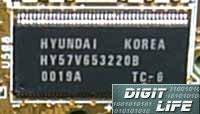 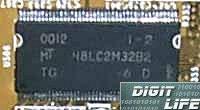 ASUS AGP-V7100/T ASUS AGP-V7100/DVI
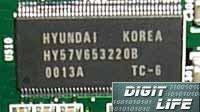 NVIDIA GeForce2 MX
The chips of memory are produced by corporations Hyundai and Micron and they work on operating frequency 166 MHz. The memory also functions on this frequency. Rather interesting features of the given cards are the absence of active ˝ooler for videocards ASUS AGP-V7100 and availability only needle dissipater but of the large size. Certainly it is possible to speak about excessive saving of the corporation on one-dollar ventilators however tests have shown that the chip GeForce2 MX practically remains only warm after long intensive operation therefore it is quite enough to have such dissipater. At much smaller size of a crystal the tank for chipset NVIDIA GeForce2 MX has the same sizes as for GeForce2 GTS therefore cooling descends better. On cards ASUS AGP-V7100 which are experimental samples the chip having a code name NV11 is installed. 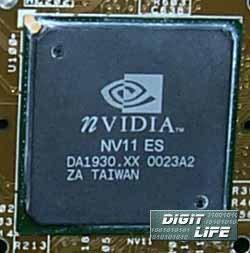 The videocard from NVIDIA has already had serially released chipset. 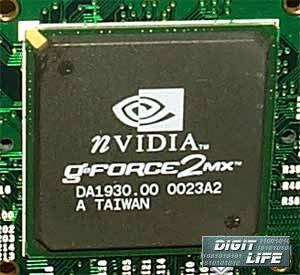 The further survey PCB of three cards has shown that there is a difference between them as at a size of cards so in a way of wiring TV-out. If for ASUS AGP-V7100/DVI and reference card TV-out is installed on a daughter card for ASUS AGP-V7100/T it is installed on basic PCB and the microcircuit Chrontel is posed on the back PCB. However in the last case TV-out is represented not only by lead-out such as S-Video but also RCA-connector. If the user does not have videoequipment receiving a signal S-Video, it is necessary to have a reducer to activate TV-out. As follows from the title videocards ASUS AGP-V7100/DVI and reference card provides connection of digital screen monitors with the interface DVI to it. On a card from ASUS TV-out is provided by the microcircuit Chrontel and on reference card by BrookTree. All cards from ASUS have a deep yellow colour and reference card is bright green. The videocards we had were in OEM-form (because they were prototypes) therefore I can say nothing about deliveries and completing them by the software. OverclockingIt is logical to assume that such not strongly heated chip can be well overclocked. Especially at installation of external additional cooling. And really we could overclock the chip up to frequency 220 MHz in all cards but memory refused to work above 210 MHz on three cards. Therefore we can expect significant increase of productivity at operation with 16 bit depth of colour in a mode of overclocking, i.e. at the boosted frequencies GPU and memory. The increase of productivity at 32-bit depth of colour should not be expected because of so essential overclocked video memory. Even if a graphic core is very much overclocked, the problem with transmission capacity of video memory still exists. So that the key parameter is again the productivity of local video memory as well as in a case with cards on the basis Georce 256/GeForce2 GTS. I have already marked that the installation on a card with NVIDIA GeForce2 GTS rather slow memory with a resulting clock rate 333 MHz makes a videocard unbalanced in whole. The similar situation was watched with cards on the basis NVIDIA GeForce 256 with the installed local video memory such as SDR SDRAM. In a case with GeForce2 MX the situation is similar. Installation and driversNow we shall pass on a practical part of our review. For the beginning I shall present the configuration of test desks:
On both desks the screen monitors ViewSonic P810 (21") and NOKIA 447Xav (17") were used. The operation with any videocard starts with installation of drivers. Therefore we also shall begin with consideration delivered by the company ASUSTeK drivers. At testing the drivers from ASUSTeK of the version 5.30a beta (on the basis drivers from NVIDIA of the version 5.30) were used: 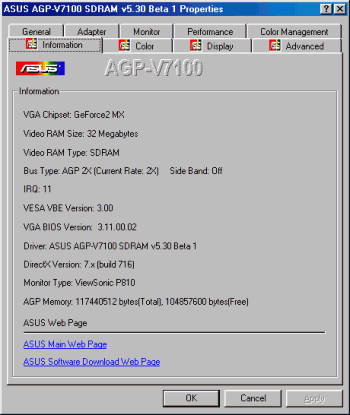 Practically all configurations the 3D-graphics included in structure of reference drivers from NVIDIA is presented and in the given package of drivers. As we already repeatedly considered features of drivers from ASUS, today we shan't analyse them in detail. I want to note that the drivers from a card could not recognise availability AGP 4x for the system board and the mode of operation AGP higher 2x was not possible. I also want to mark that by tradition of configuration drivers from ASUS it is possible to call through the manager in a task bar below on the right: 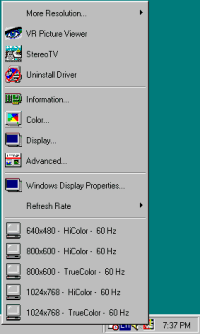 It was not noticed any more differences from regular drivers of the last generation from ASUS. You can see new configurations dedicated to the effect anti-aliasing in sections Direct3D and OpenGL. Reference card was tested on drivers NVIDIA 5.30. Results of the testsWe shall begin with 2D-graphics. I can state with pleasure that for all considered cards all indexes in 2D are not worse than for cards on basis NVIDIA GeForce2 GTS. The videocards of the similar class provide needs in the qualitative image absolute majority of the users. Implementation DVC in drivers was not detected in any special form. Among configurations of drivers nothing was found about this except standard installations a range of colours. Visually quality of a 2D-picture was at level NVIDIA GeForce2 GTS. At the following consideration of videocards on the basis NVIDIA GeForce2 MX we shall return to consideration of implementation DVC on cards of this class. So the videocards ASUS AGP-V7100/T, AGP-V7100/DVI and also standard card from NVIDIA provide excellence of the image in 2D-graphics and by its indexes is on a very high level. We shall analyse high-speed indexes of videocards on the basis NVIDIA GeForce2 MX in 3D-graphics using two games:
It is quite enough of these instruments to show productivity of a videocard by operation through two fundamental API. For visualisation on the diagrams you can see the high-speed indexes of two videocards: Creative 3D Blaster GeForce256 Annihilator (NVIDIA GeForce256 SDR) and Creative 3D Blaster GeForce256 Annihilator Pro (NVIDIA GeForce256 DDR). Also we shall show as the productivity of videocards ASUS AGP-V7100/T and AGP-V7100/DVI in a mode of overclocking has changed. Anticipating results I want to mark that both cards have shown completely identical productivity, the differences were so insignificant that there is no sense to show on diagrams both cards therefore the results of ASUS AGP-V7100/DVI are represented below.   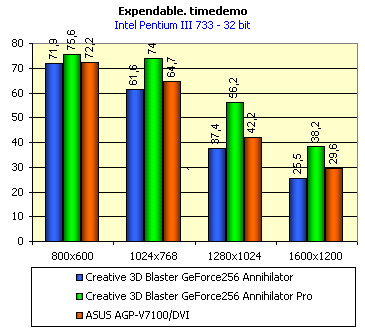 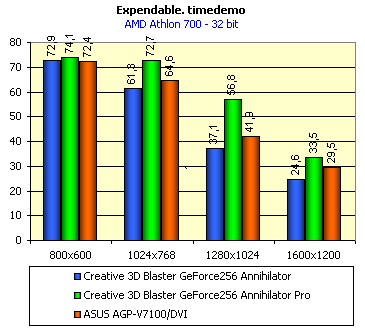 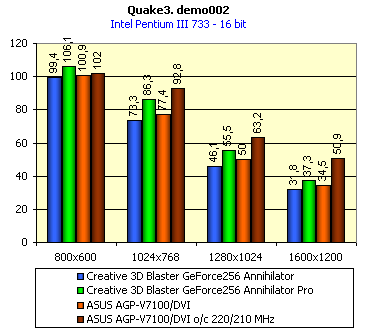 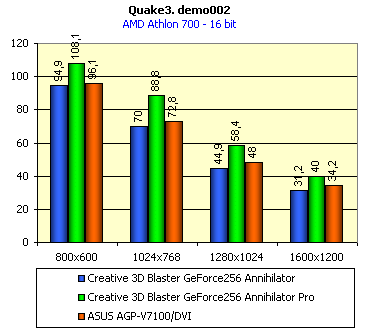 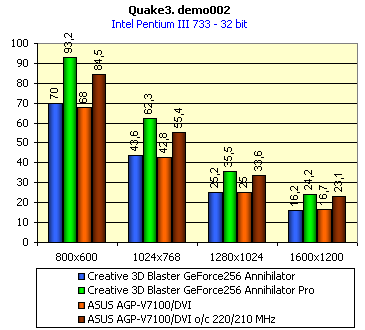 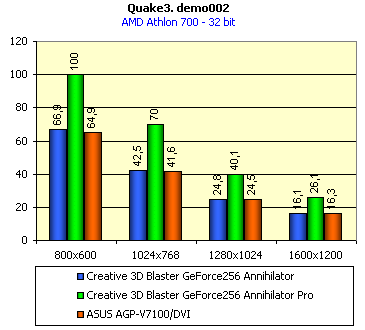 Unfortunately we got reference card from NVIDIA later than cards from ASUS therefore I analysed the operation of Z-buffer on basis of a standard card. As I have already marked in features of videocards on basis this chipset they allow at operation in 32-bit colour by means of the game to switch depth of colour for Z-buffer in 16 bits (by default all remaining cards on chipsets from NVIDIA include 24-bit Z-buffer by operation with 32-bit graphics and 16-bit by operation with 16-bit graphics). For example in Quake3 it is possible through variable r_depthbits to install value "16" for Z-buffer at operation with 32-bit graphics (for example mode High Quality). 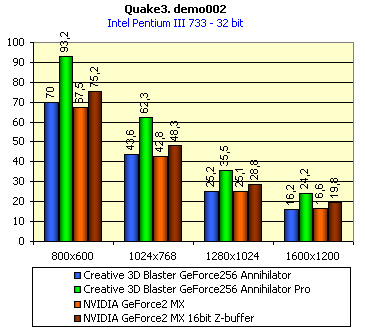 As we see the saving of transmission capacity of video memory by the consumption it by Z-buffer gives rather high effect. I should also mark that I have not noticed special ˝hange in quality of graphics in Quake3 at 16-bit Z-buffer and 32-bit mode of geometry in whole. Occasionally on very far posed objects there some "moving" pixels but they don't spoil a common picture. For matching I have looked at implementation of the same blend mode for Matrox G400 and have seen that though there are no well noticeable artefacts the increase on rate is not present (for videocards on basis Matrox G400 practically there are no problems with insufficient transmission capacity of memory, the problem there is in the chipset power). By the way as far as I know the support of a mode Color/Z-buffer depth mixed mode is not something especial. Basically the correspondence of depth Z-buffer to depth of the frame buffer at rendering is the rule for MS Direct3D 6.0 and all following versions. Before Direct3D 6.0 there was a possibility to use different depth of Z-buffer and frame buffer at rendering. Nevertheless NVIDIA just kept in availability for variation the parameter in the list: VALIDATEZMETHOD=2: can accept different depth (default)
In result NVIDIA forces DX7 applications to use set values of buffers depth. It is done to boost productivity and to bypass some possible limiting in the hardware. By consideration of speed indexes of cards on NVIDIA GeForce2 MX it is possible to note that the indexes of productivity in whole are a bit above than for a videocard on basis NVIDIA GeForce 256 SDR that was expected. In 32-bit colour differences from NVIDIA GeForce 256 SDR are practically not present. But the results obtained by operation on not regular frequencies i.e. in a mode of overclocking are noticeable at once. The increase in speed is rather great in 16-bit colour and is not noticeable in 32-bit colour. I shall mark that the cards worked at support external additional cooling (only one additional ventilator for good circulation of air was installed in the system block). Certainly I can not extrapolate the results of overclocking given cards on all cards on basis GeForce2 MX, however there are all bases to hope, that the fans of overclocking can select a proper copy for the needs. Additional functionsI do not have screen monitor with the DVI-interface therefore I could not test operation of DVI-Connector but I could test TV-out. Because of absence in drivers the support of TwinView I did not manage to receive simultaneous reproduction of a picture both on the screen monitor and on the TV set (TwinView will allow it), but in the remaining operation with TV-Out is quite common - permission 800x600 and lead-out either on the screen monitor or on the TV set: As to playing DVD-Video then the situation is about the same as in a case with videocards on the basis NVIDIA GeForce2 GTS. NO DVD-player was delivered together with videocards and therefore the tests were with usage WinDVD of the version 2.1. The quality of the image was excellent , the percent of loading the processor was not more than 27%. SummarySo the cards ASUS AGP-V7100/T, AGP-V7100/DVI and the standard card from NVIDIA have shown us what new GPU NVIDIA GeForce2 MX can give to a user. The new chip from NVIDIA is not famous for high-speed qualities because of slow memory therefore cards on its base are a certain compromise between productive 3D accelerator and a card giving additional service to the user by high quality in 2D, an output on TV available practically for all videocards of this class, the lead-out to digital screen monitors and technology TwinView (when it will be in drivers). As for the price the stated sum in $150-170 seems to be too overestimated because to the majority of the users these cards will bring nothing new in comparison with NVIDIA GeForce 256 SDR except the additional costs at a purchase. There are not enough users of screen monitors with DVI interface in Russia (and all over the world) therefore the only reasons of such price are availability on cards TV-out and the fact of release new cards which will make a competition to already available ones that will lead to the fall of the prices and it is the positive factor. After the possibility to use technology TwinView appears, the cards on GeForce2 MX will become more attractive for a purchase. Possibilities on implementation FSAA (effect anti-aliasing) were not considered by me on purpose as this function takes a lot of productivity providing not so excellent result even on cards with GeForce2 GTS. And it is at power of this GPU having fantastic fillrate! What to speak about GeForce2 MX on which usage of a mode FSAA practically is not interesting. Pluses:
Minuses:
Write a comment below. No registration needed!
|
Platform · Video · Multimedia · Mobile · Other || About us & Privacy policy · Twitter · Facebook Copyright © Byrds Research & Publishing, Ltd., 1997–2011. All rights reserved. |